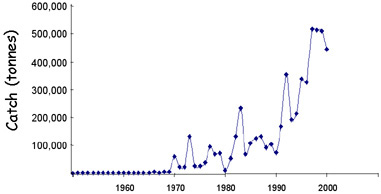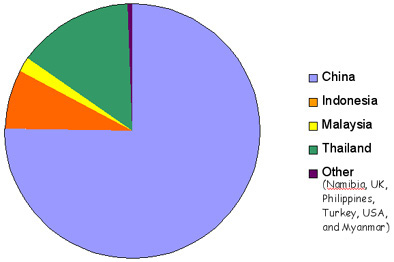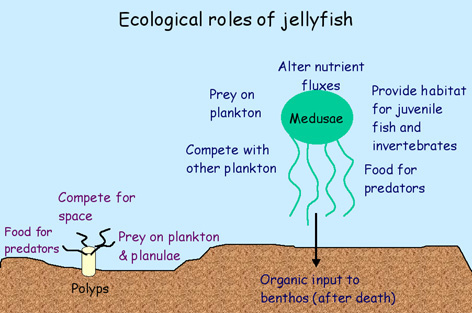
Fig. 1. Annual world harvest of jellyfish. Source: United Nations Food and Agriculture Organization 2000.
Only jellyfish belonging to the Order Rhizostomeae are harvested for food. The rhizostomes are favoured because they are typically larger and have more rigid bodies than other scyphozoan orders. When processed, the rhizostomes produce a product that has the desirable, almost crunchy texture. Some species considered to be edible are:
Cepheidae
Catostylidae
Lobonematidae
Rhizostomatidae
Stomolophidae
(Omori
& Nakano 2001)

Fig. 2. Relative quantity of jellyfish caught by different countries during 2000.
Source: United Nations Food and Agriculture Organization 2000.
Jellyfish frequently occur in dense aggregations or blooms and this makes them relatively easy to harvest. Jellyfish are caught using a variety of netting techniques including dip-nets, seines and trawls (Omori 1981, Kingsford et al. 2000). In the USA, Stomolophus meleagris has been harvested using pair trawlers, shrimp trawlers, purse-seiners and "tunnel" boats (Rudloe 1997). Due to concerns about by-catch (i.e. catching undersize animals or other non-target species), harvesting of Catostylus mosaicus in Australia is largely limited to dip-netting since this enables fishers to selectively target large medusae and minimises incidental collection of non-target species (Kingsford et al. 2000).
Jellyfish need to be processed within a few hours of being harvest since they spoil quickly. Jellyfish are dried using a combination of alum and salt. Drying is a step-wise process that can take between 20 and 40 days to complete (Hsieh et al. 2001). Live jellyfish consist mainly of water and the jellyfish loses approximately 90% of its weight during the drying process. Both the bell and the oral arms are utilised.
Jellyfish is most commonly eaten as a type of salad. The dried jellyfish is desalted and rehydrated by soaking it in water for several hours or overnight (Hsieh et al. 2001). It is then shredded or sliced into strips, mixed with various sauces, vegetables, meats (e.g. chicken) or other seafood and served cold.
Medusae are important members of the pelagic community (Fig. 3). They are voracious predators of plankton (Purcell 1992) and they, themselves, are preyed on by fish (Ates 1988), turtles and birds (Ates 1991). Species that contain symbiotic zooxanthellae are known to actively take up inorganic nutrients such as nitrogen from seawater (Muscatine & Marian 1982) and such species may have a role in regulating nutrient dynamics of coastal systems. Jellyfish also provide habitat for many species of juvenile fish and some crustaceans (Kingsford 1993). Removal of large quantities of jellyfish via commercial harvesting may have negative impacts on the wider ecosystem. Much more research on the ecological impacts of harvesting jellyfish is required.

Fig. 3. Ecological roles of medusae and polyps. Adapted from Kingsford et al. 2000.
Jellyfish are relatively short-lived (often less than a year), grow very rapidly (up to several mm per day [Kikinger 1992]) and consequently abundances of jellyfish can vary dramatically over periods of weeks to months (Pitt & Kingsford 2000). Although jellyfish may occur at predictable times of the year in some places (Brewer 1989), in other locations it is difficult to predict when jellyfish will appear. Many finfish fisheries are managed on a quota system, where a fixed quantity of the target species is harvested. This usually requires a basic knowledge of the abundance of the target species. Since abundances of jellyfish fluctuate greatly over time and the appearance of jellyfish is often unpredictable, alternative management strategies may be required. Examples of some of the information required to effectively manage jellyfish fisheries are: